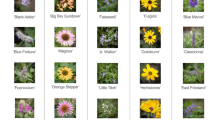Summary
Research into local (neighborhood) competition has heretofore focused on either natural populations of long-lived woody plants or artifical populations of herbaceous annuals. To explore the usefulness of these techniques for herbaceous perennials, 1 applied them to 11 natural populations of 4 species of violet (Viola blanda, V. pallens, and V. incognita, alone and with V. adunca). Ramet density ranged from 132 to 508 per square meter. The analysis tried to account for the size of each ramet (expressed as the number of leaves) using information on the number, size, and angular aggregation of neighboring plants in three concentric annuli (0–3, 3–6, and 6–9 cm). Simple rank correlations between leaf number and these measures of local competition were usually of the expected sign, but were consistently significant in only two of the populations (1 pallens and 1 incognita). No significant correlations were of the “wrong” sign. When the spatial independent variables were combined into multiple regression equations they accounted for between 5 and 59% of the total variance in leaf number. The equations were best in predicting individual size in the Newfoundland populations of V. incognita which had the greatest range in individual size. Total plant density appeared unrelated to predictive success.
The neighborhood competition approach can be applied to natural populations of herbaceous perennials, but low density, inaccurate measures of plant performance and microvariation in site quality limit its usefulness. In particular, it seems impossible to determine the mechanism by which neighbors exert their competitive effects with this approach.
Similar content being viewed by others
References
Barr AJ, Goodnight JH, Sall JP, Helwig JT (1976) A user's guide to SAS 76. Sparks Press, Raleigh, NC
Bella IE (1971) A new competition model for individual trees For Sci 17:63–72
Bratton SP (1976) Resource division in an understory herb community: responses to temporal and microtopographic gradients. Am Nat 110:679–693
Cook RE (1979) Patterns of juvenile mortality and recruitment in plants. In: OT Solbrig et al (eds), Topics in Plant Population Biology. Columbia University Press, New York, pp 207–231
Daniels RF (1976) Simple competition indeces and their correlation with annual Loblolly pine tree growth. For Sci 22:454–456
DeWit CT (1960) On competition. Versl Landbouwk Onderz 66:1–82
Fernald ML (1950) Gray's Manual of Botany, Eighth ed. D Van Nostrand, New York
Gottleib LD (1977) Genotypic similarity of large and small individuals in a natural population of the annual plant Stephanomeria exigua ssp coronaria (Compositae). J Ecol 65:127–134
Harper JL (1977) Population Biology of Plants. Academic Press, New York
Harper JL (1980) Plant demography and ecological theory. Oikos 35:244–253
Harper JL, Bell AD (1979) The population dynamics of growth form in organisms with modular construction. In: RL Anderson (ed), Population Dynamics, Blackwells, Oxford
Kays S, Harper JL (1974) The regulation of plant and tiller density in a grass sward. J Ecol 62:97–105
Mack RN, Harper JL (1977) Interference in dune annuals: spatial pattern and neighbourhood effects. J Ecol 65:345–363
Mead R (1966) A relationship between individual plant spacing and yield. Ann Bot NS 30:301–309
Newell SJ Translocation of 14C-photoassimilate in two stoloniferous Viola species, Submitted, Am Nat
Newell SJ, Solbrig OT, Kincaid DT (1981) Studies on the population biology of the genus Viola 3. The demography of Viola blanda and Viola pallens. J Ecol (in press)
Obeid M, Machin D, Harper JL (1967) Influence of density on plant variation in fiber flax, Linum usitatissimum L. Crop Sci 7:471–473
Opie JE (1968) Predictability of individual tree growth using various definitions of competing basal area. For Sci 14:314–323
Ross MA, Harper JL (1973) Occupation of biological space during seedling establishment. J Ecol 60:77–88
Schellner RA, Newell SJ, Solbrig OT (1981) Studies on the population biology of the genus Viola 5. Spatial analysis of ramets and seedlings in three stoloniferous species. J Ecol (in press)
Solbrig OT, Newell SJ, Kincaid DT (1980) The population biology of the genus Viola I. The demographics of Viola sororia. J Ecol 68:521–546
Werner PA (1976) Ecology of plant populations in successional environments. Syst Bot 1:246–268
Werner PA (1977) Colonization success of a “biennial” plant species: experimental field studies of species cohabitation and replacement. Ecol 58:840–849
White J (1979) The plant as a metapopulation. Ann Rev Ecol and Syst 10:109–145
Zar JH (1974) Biostatistical Analysis. Prentice Hall, Englewood Cliffs
Author information
Authors and Affiliations
Rights and permissions
About this article
Cite this article
Waller, D.M. Neighborhood competition in several violet populations. Oecologia 51, 116–122 (1981). https://doi.org/10.1007/BF00344661
Received:
Issue Date:
DOI: https://doi.org/10.1007/BF00344661




